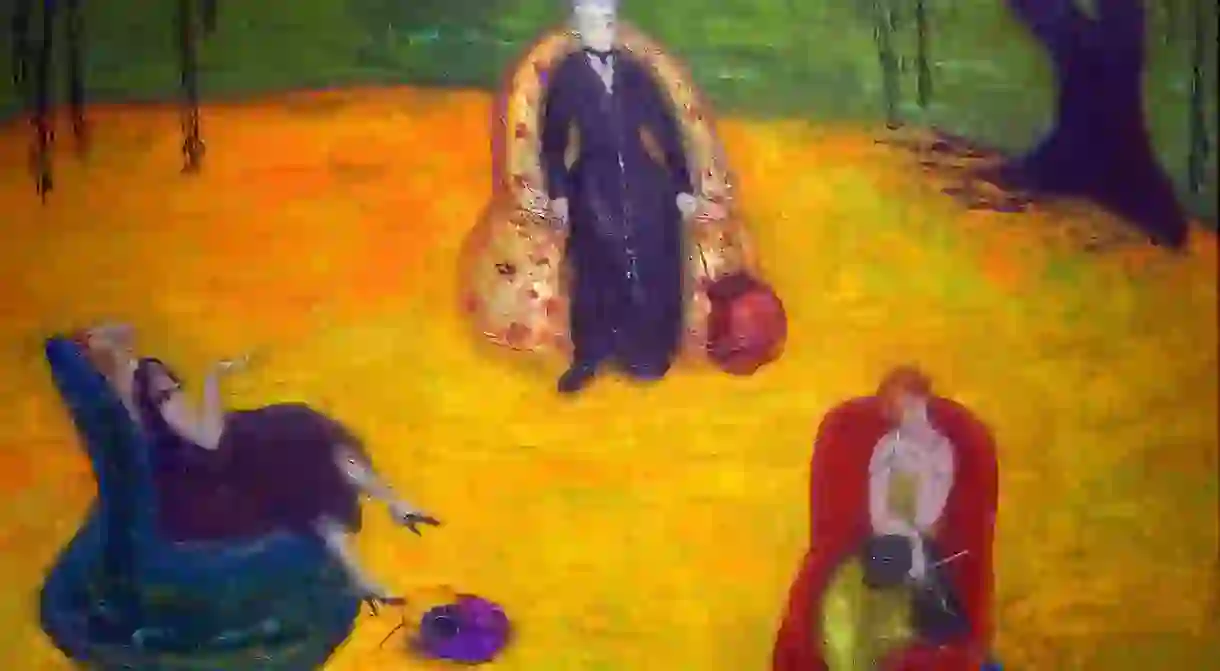Florine Stettheimer: A Reluctantly Famous NYC Artist

Florine Stettheimer was a prolific American painter, designer, and poet who lived at the beginning of the 20th century. Although she was an appreciated member of the Modernist art community, she was reluctant to show her work publicly. We explore Florine Stettheimer’s peculiarly quiet rise to fame.
Florine Stettheimer was born in Rochester, New York on August 19th, 1871 to a prominent immigrant German-Jewish banker. Her wealth afforded her the opportunity to travel with ease between the United States and Europe. While away studying in Germany, her father abandoned the family, which subsequently strengthened the bond between Stettheimer, her mother, and her two younger sisters, Carrie and Ettie. To escape World War I, they permanently moved back to New York City in 1914. Stettheimer and her sisters remained single and lived with their mother until her death in 1935.

Having been exposed to the arts and the bohemian lifestyle in Europe, Stettheimer and her family quickly immersed themselves in the prominent art circles of New York City. They began hosting a salon series that attracted prominent intellectuals, writers, and avant-garde artists of the time, including Marcel Duchamp, Francis Picabia, Marsden Hartley, Carl Van Vechten, Alfred Stieglitz, and Georgia O’Keefe. The salons were advertised between 1915 and 1935 “for the contemporary literati, gay, and polyglot New Yorkers and European expatriates.”
Florine Stettheimer can be identified as both a Primitive and a Modernist painter with a unique sense of humor and social commentary built into her compositions. She had a traditional art background, having studied at the Art Students League of New York, but it was a visit to the Ballets Russes that is said to have truly influenced her aesthetic. Her work evokes a sense of theatrics through active compositions and the ability to document space. Her paintings offer a lively, diary-like account of her upper-class lifestyle and famous friends. The artists that attended her family’s salons are often depicted in her paintings.

Although Stettheimer was a prolific painter, she often chose to show her work privately rather than in large exhibitions. She had one solo exhibition at Knoedler & Company in 1916, but she was so disappointed by the public’s reception to her work that she showed her work only at her salons and in small group exhibitions afterwards. Her best-known work was her four-part Cathedrals series, which documented the Financial District, Theater District, a department store, and a museum. She died while working on the last painting, Cathedrals of Art. After her death, her good friend Marcel Duchamp organized the first retrospective of her work at the Museum of Modern Art in 1946. The show was so successful that it traveled to the Whitney Museum of American Art in 1950. Her Cathedrals series has also been on display at the Metropolitan Museum of Art.

Stettheimer was also an accomplished poet, but she chose to send her work to friends rather than having any of it published. It was not until after her death that her collection of poems, Crystal Flowers, was published in 1949. It was initially published in a small edition of 250, but it was so successful that it was re-printed in 2010 on a larger scale with a few previously unpublished poems and a libretto for her ballet, Orphée of the Quat-z-arts.
The true definition of a Renaissance woman, Stettheimer is perhaps best known for her costumes and set designs. She designed both the costumes and sets for Four Saints in Three Acts, an avant-garde opera by Gertrude Stein and Virgil Thomas. The cellophane backdrops and colorful lace costumes received as much attention in the press as the actual performance. In fact her costumes have since been referenced frequently in women’s fashion. Stettheimer’s unique set designs can also be seen in her sister Carrie’s Stettheimer Dollhouse, which is part of the permanent collection of the Museum of the City of New York. The dollhouse offers a glimpse into an upper-class household and is filled with paintings by famous artists, including a three-inch version of Nude Descending a Staircase custom designed by Marcel Duchamp.
When Stettheimer passed away, she left her sisters explicit instructions to have her work destroyed. Fortunately for the city of New York, Ettie defied her sister’s wishes. Although many of Stettheimer’s paintings have been shown in museums around the world and a book of her poems has been published, Ettie did edit her sister’s diaries to ensure that certain details of her life would never be disclosed to the general public.













